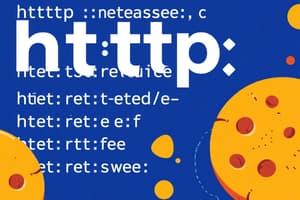Podcast
Questions and Answers
In the context of web development, what does URL encoding ensure when transmitting data in a query string?
In the context of web development, what does URL encoding ensure when transmitting data in a query string?
It ensures that special characters are properly transmitted without being misinterpreted by the server or browser.
Explain the difference between GET and POST HTTP methods in terms of data submission and URL visibility.
Explain the difference between GET and POST HTTP methods in terms of data submission and URL visibility.
GET appends data to the URL, making it visible, while POST sends data in the body of the HTTP request, thus not visible in the URL.
Describe a scenario where using localStorage would be more appropriate than using sessionStorage in a web application.
Describe a scenario where using localStorage would be more appropriate than using sessionStorage in a web application.
localStorage is more appropriate when data needs to be persistent across multiple sessions, such as user preferences or settings that should be remembered.
What is the primary function of a web browser's developer tools, and give an example of how it aids in debugging?
What is the primary function of a web browser's developer tools, and give an example of how it aids in debugging?
Explain the concept of responsive web design and how it enhances user experience across different devices.
Explain the concept of responsive web design and how it enhances user experience across different devices.
How does CSS specificity determine which style rules are applied to an element when there are conflicting rules?
How does CSS specificity determine which style rules are applied to an element when there are conflicting rules?
Describe the purpose of using a viewport meta tag in an HTML document and its impact on mobile browsing.
Describe the purpose of using a viewport meta tag in an HTML document and its impact on mobile browsing.
How would you use JavaScript to dynamically change the text content of an HTML element with the ID "myElement"?
How would you use JavaScript to dynamically change the text content of an HTML element with the ID "myElement"?
Explain what a CORS error is and why it occurs. Provide a basic solution to resolve it for web development.
Explain what a CORS error is and why it occurs. Provide a basic solution to resolve it for web development.
What is the DOM (Document Object Model), and how does JavaScript interact with it?
What is the DOM (Document Object Model), and how does JavaScript interact with it?
Explain the purpose of using alt text for images in HTML. Why is it important for accessibility and SEO?
Explain the purpose of using alt text for images in HTML. Why is it important for accessibility and SEO?
Describe the difference between cookies and sessions in web development, focusing on how they store user data and maintain state.
Describe the difference between cookies and sessions in web development, focusing on how they store user data and maintain state.
What are the advantages of using a CSS preprocessor like Sass or Less over traditional CSS?
What are the advantages of using a CSS preprocessor like Sass or Less over traditional CSS?
Explain the concept of event delegation in JavaScript and why it is useful for improving performance, particularly in large applications.
Explain the concept of event delegation in JavaScript and why it is useful for improving performance, particularly in large applications.
What is the purpose of using a git branching strategy, such as Gitflow, in a software development project?
What is the purpose of using a git branching strategy, such as Gitflow, in a software development project?
Describe the differences between synchronous and asynchronous JavaScript, particularly in the context of handling network requests or long-running operations.
Describe the differences between synchronous and asynchronous JavaScript, particularly in the context of handling network requests or long-running operations.
Explain what a RESTful API is, and list 2-3 common HTTP methods used in RESTful interactions, describing their typical usage.
Explain what a RESTful API is, and list 2-3 common HTTP methods used in RESTful interactions, describing their typical usage.
Describe the concept of closures in JavaScript and provide a simple example of how they can be used.
Describe the concept of closures in JavaScript and provide a simple example of how they can be used.
What is the difference between == and === in JavaScript, and why is it generally recommended to use ===?
What is the difference between == and === in JavaScript, and why is it generally recommended to use ===?
Explain the use of try...catch blocks in JavaScript and how they handle exceptions during code execution.
Explain the use of try...catch blocks in JavaScript and how they handle exceptions during code execution.
Flashcards are hidden until you start studying




